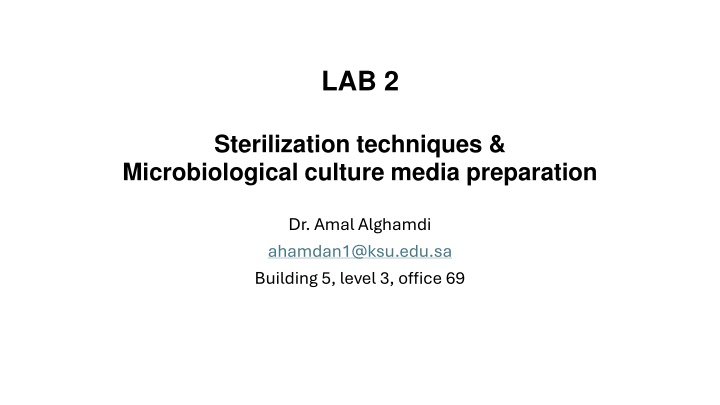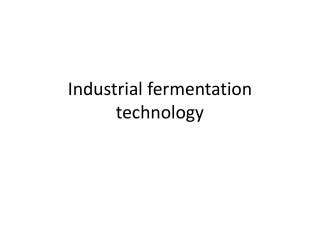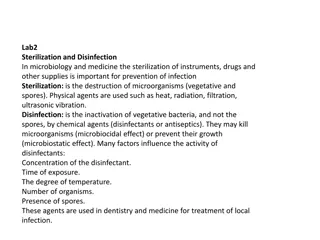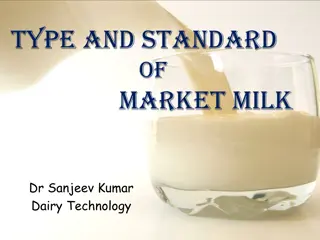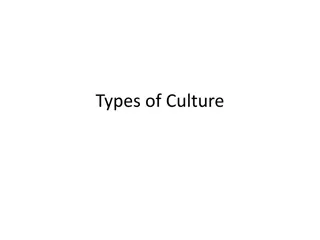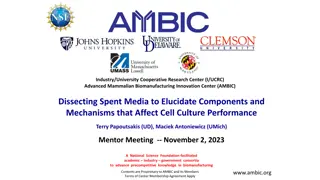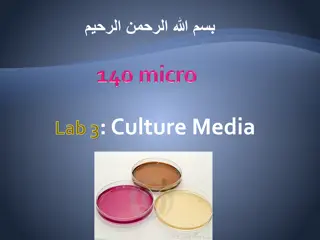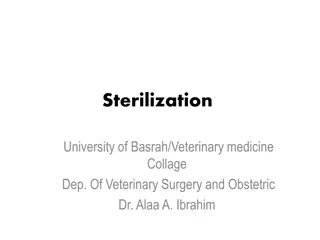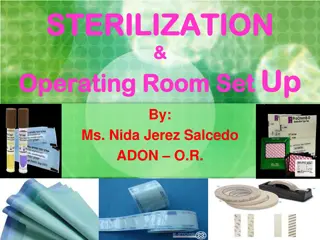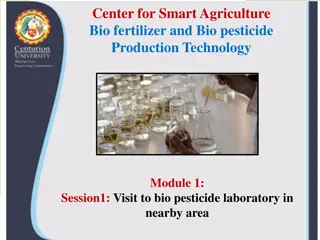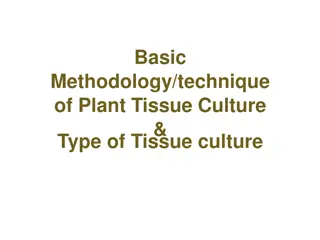Sterilization Techniques in Microbiological Culture Media Preparation
Sterilization is crucial in microbiological culture media preparation to ensure a contamination-free environment for microbial growth. This involves techniques such as autoclaving, dry heat, and filtration to eliminate all life forms. Autoclaving, the most common method, uses steam under pressure to sterilize media and glassware effectively. Proper procedures for autoclaving are outlined, emphasizing the significance of maintaining sterile conditions for optimal microbial culture outcomes. Different types of culture media, including complex and defined media, are discussed based on their nutrient composition and applications in supporting microbial growth.
Download Presentation

Please find below an Image/Link to download the presentation.
The content on the website is provided AS IS for your information and personal use only. It may not be sold, licensed, or shared on other websites without obtaining consent from the author.If you encounter any issues during the download, it is possible that the publisher has removed the file from their server.
You are allowed to download the files provided on this website for personal or commercial use, subject to the condition that they are used lawfully. All files are the property of their respective owners.
The content on the website is provided AS IS for your information and personal use only. It may not be sold, licensed, or shared on other websites without obtaining consent from the author.
E N D
Presentation Transcript
LAB 2 Sterilization techniques & Microbiological culture media preparation Dr. Amal Alghamdi ahamdan1@ksu.edu.sa Building 5, level 3, office 69
Sterilization of Media and glassware Sterilization is the process of rendering a medium or material free of all life forms. There are three basic ways to sterilize media and supplies. Three ways for sterilizing culture media and supplies (glassware): Steam under pressure (autoclaving) 121oC at 15 pounds of pressure for 15 minutes Dry heat 160 to 170oC for 2 hours Millipore filtration passage through filters with pore sizes no greater than 0.22 lm 1) 2) 3) Autoclaving: The most useful approach is autoclaving, in which items are sterilized by exposure to steam at 121 C and 15 lbs of pressure for 15 minutes or longer, depending on thei r n a t u r e . Under these conditions, microorganisms, even endospores, will not survive for 12 to 13 minutes. This method is rapid and dependable.
Procedure for Autoclaving 1.Load the autoclave with the freshly prepared culture media. 2.Close and lock the autoclave door. 3.Set the autoclave time for 15 minutes or longer. 4.Make certain that the autoclave temperature is set to 121 C. 5.Start the autoclave by pushing the start button or twisting the knob to the start position. 6.When the period of sterilization is completed, and the pressure in the chamber reads 0, 7.Carefully open the door and remove the containers, using heat-proof gloves.
Microbiological Culture Media Microorganisms depend on a number of factors such as nutrients, oxygen, moisture and temperature to grow and divide. In the laboratory, except for the above factors, the culture medium should be sterile and contamination of a culture with other organisms should be prevented. The survival and growth of microorganisms depend on available nutrients and a favorable growth environment. In the laboratory, the nutrient preparations that are used for culturing microorganisms are called media (singular, medium). Depending on the type and combination of nutrients, different categories of media can be made.
Media categories: 1.Complex media are rich in nutrients, they contain water soluble extracts of plant or animal tissue (e.g., enzymatically digested animal proteins such as peptone and tryptone). Usually a sugar, often glucose is added to serve as the main carbon and energy source. The combination of extracts and sugar creates a medium which is rich in minerals and organic nutrients, but since the exact composition is unknown, the medium is called complex. 2.Defined media are media composed of pure ingredients in carefully measured concentrations dissolved in double distilled water i.e., the exact chemical composition of the medium is known. Typically, they contain a simple sugar as the carbon and energy source, an inorganic nitrogen source, various mineral salts and if necessary growth factors (purified amino acids, vitamins, purines and pyrimidines).
Media categories: 3- Selective/differential media are media based on either of the two categories above supplemented with growth-promoting or growth-inhibiting additives. The additives may be species- or organism-selective (e.g., a specific substrate, or an inhibitor such as cyclohexamide (artidione) which inhibits all eucaryotic growth and is typically used to prevent fungal growth in mixed cultures). Three physical forms of media are used: 1.liquid or broth media 2.semisolid media 3.solid media
The major difference among these media is that solid and semisolid media contain a solidifying agent (usually agar), whereas a liquid medium does not. Liquid media (broth), the only difference between broth and agar media is that broths do not contain an agar component. Nutrient broth, tryptic soy broth, or brain-heart infusion broth, can be used to propagate large numbers of microorganisms in fermentation studies and for various biochemical tests. Semisolid media can also be used in fermentation studies, in determining bacterial motility, and in promoting anaerobic growth. Solid media, such as nutrient agar or blood agar, are used (1) for the surface growth of microorganisms in order to observe colony appearance, (2) for pure culture isolations, (3) for storage of cultures, and (4) to observe specific biochemical reactions.
Uses of Culture Media Broth: to grow high concentration of bacteria Slant: Space-saving solid culture Plate: Isolating individual colonies, can be used to count bacteria Deep: Look at motility & oxygen requirement
Pouring of Culture Media Nowadays, we use clear plastic disposable Petri dishes, typically 95 or 100 mm in diameter, 20 per sleeve (packet). When prepared for inoculation, a plate contains solid agar mixed with nutrient materials to provide a surface for growth. We prepare agar media by mixing 1 to 2% agar with individual components or using a pre-mixed powder. Either way, the dry components must be heated to melt the agar, sterilized in a flask or bottle, then poured into the plates using an aseptic technique, preferably in a sterile cabinet (laminar flow hood).
How to prepare a Petri plate Take liquid agar (in the water bath) Pour aseptically into the base of the Petri plate. Wait until solidify (15 minutes). ***Plates are kept inverted so condensation does not drip onto the agar. To increase the shelf-life of the plates, store in a cool, dry environment until they are used (refrigerator).
Labeling Plate Make certain that all plates are labeled on the bottom half. Include the following: 1. Your initials or identifying 2. mark Date 3. Type of specimen
Culture media types: Plate Deep Broth Slant
